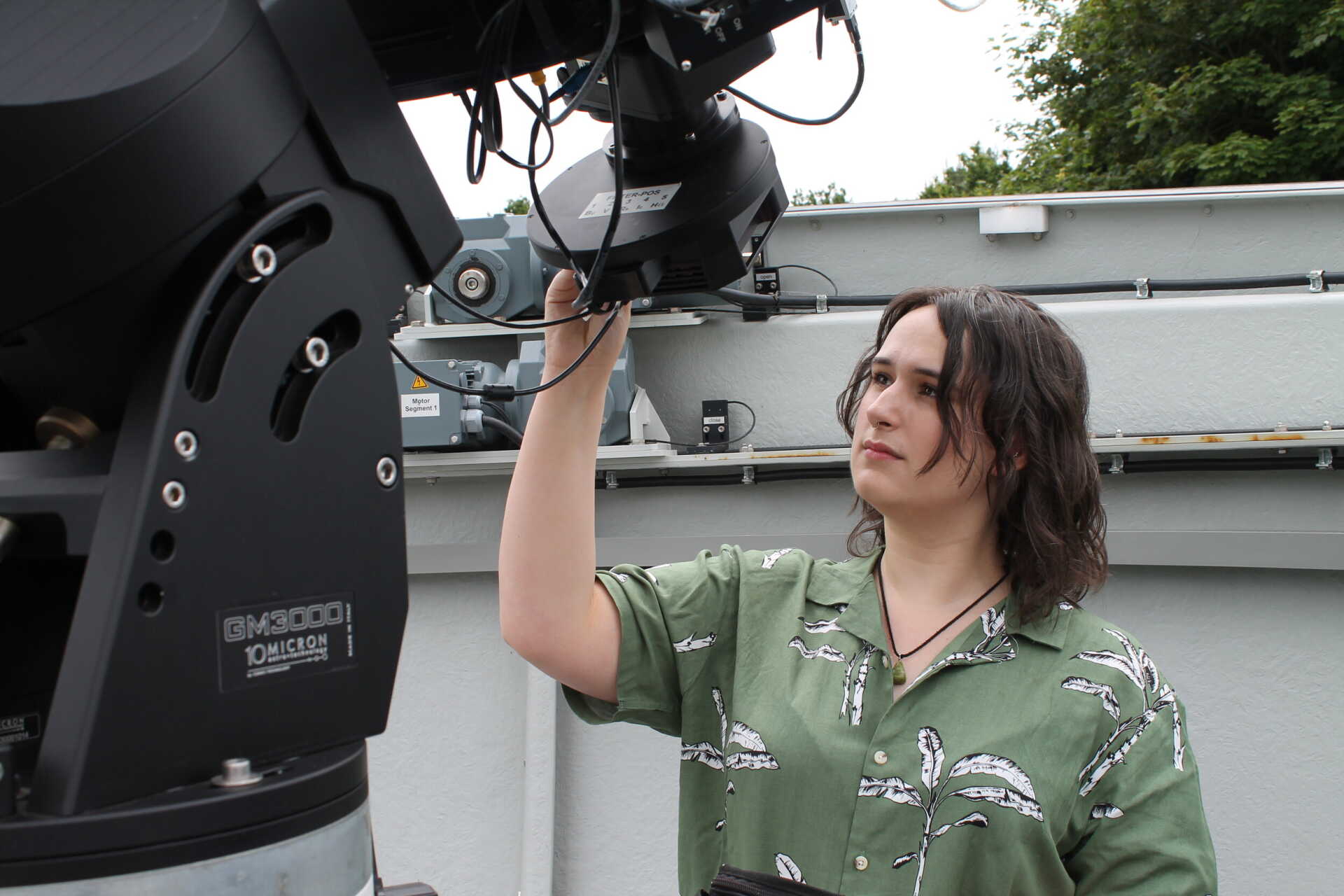
Investigate the possibilities of life elsewhere within the universe and get involved with real space missions from ESA and NASA. This degree allows you to specialise in astronomy and space – from spacecraft design to star formation and astrobiology. Using our fantastic facilities, including the Beacon Observatory, and dedicated data analysis lab module, you’ll learn from experts in the field and open up a range of careers in space science.
Our four-year integrated Master's programme (MPhys) allows you to hone the skills needed for research and technical roles in industry, or as a preparation for a PhD. Deepen your knowledge with specialised taught modules and work with an academic to carry out a real, open-ended research project.
If you don’t have a science background or don’t meet our entry requirements, you can take our foundation year.
You might also be interested in our Physics MPhys or Physics with Astrophysics MPhys degrees.
This course is fully accredited by the Institute of Physics.

Spend a year studying abroad at one of our partner universities. We currently have links with institutions in the US, Canada, Hong Kong and Switzerland.
You'll be able to move between our courses in the earlier years, ensuring you are studying the best course for you.
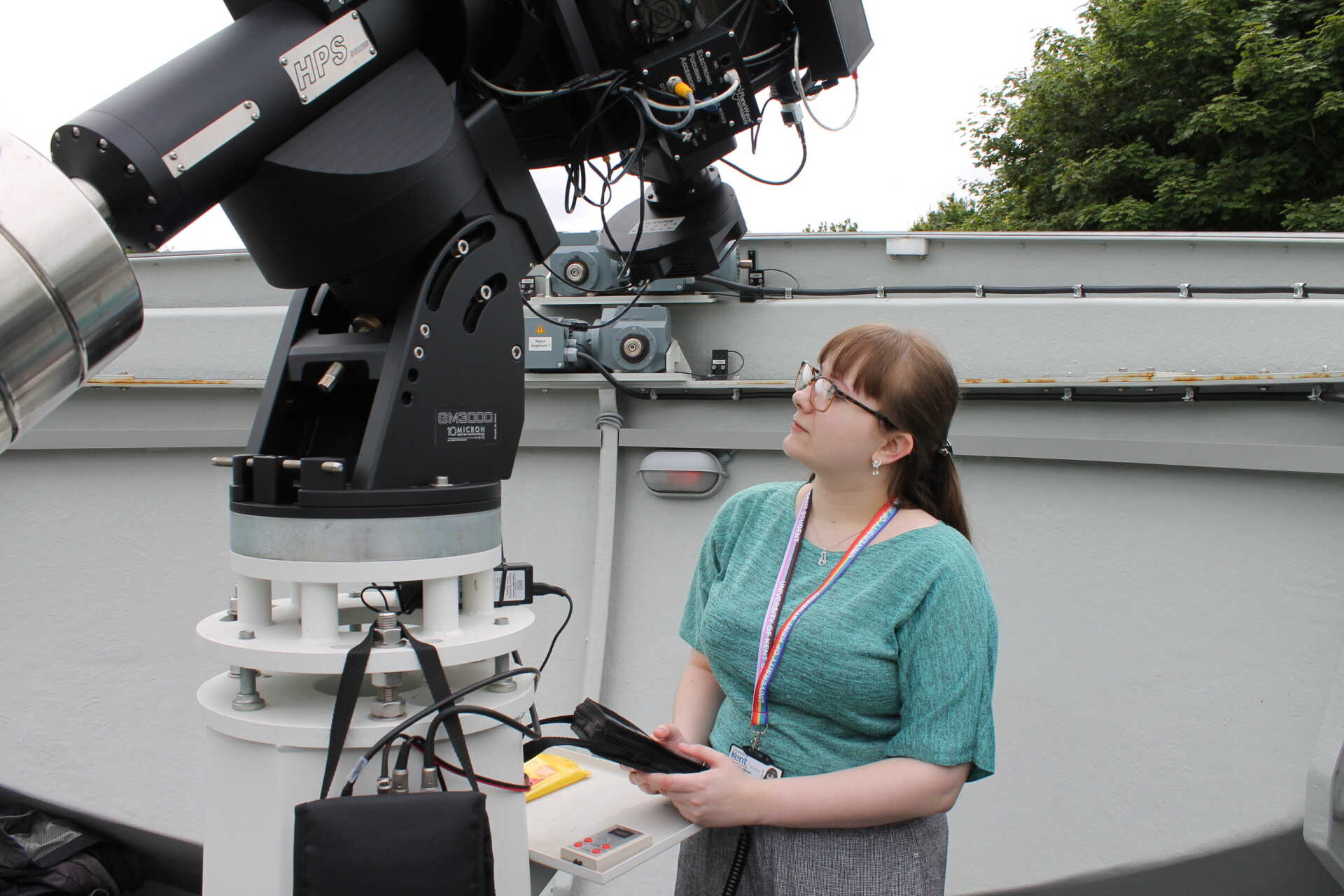
Dr Tim Kinnear and student Amber Whale describe what's great about studying at Kent from outstanding facilities to industry connections.
You'll discover the latest developments in areas such as the solar system and space science, galactic structure and planetary nebulae.

You'll use newly-refurbished physics and astronomy labs, a photonics centre and the Beacon Observatory with optical telescope.
Our typical offer levels are listed below and include indicative contextual offers. If you hold alternative qualifications just get in touch and we'll be glad to discuss these with you.
BBB including A level Mathematics or Physics (not Use of Mathematics)
The University will consider applicants holding/studying BTEC Extended National Diploma Qualifications (QCF; NQF; OCR) in a relevant science or engineering subject at 180 credits or more, on a case-by-case basis. Please contact us via the enquiries tab for further advice on your individual circumstances.
30 points overall or 14 at HL including HL Maths/Maths Method or HL Mathematics: Analysis and Approaches at 5 or SL Maths/Maths Methods at 6 (not Maths Studies/SL Maths: Applications & Interpretations).
N/A
The University will consider applicants holding T level qualifications in subjects closely aligned to the course.
The University welcomes applications from Access to Higher Education Diploma candidates for consideration. A typical offer may require you to obtain a proportion of Level 3 credits in relevant subjects at merit grade or above.
Please contact our Admissions Team for more information at studynats@kent.ac.uk.
The following modules are offered to our current students. This listing is based on the current curriculum and may change year to year in response to new curriculum developments and innovation:
You’ll focus on the fundamentals of mathematics, physics and astronomy.
This module provides an introduction to astronomy, beginning with our own solar system and extending to objects at the limits of the universe. Straightforward mathematics is used to develop a geometrical optics model for imaging with lenses and mirrors, and this is then used to explore the principles of astronomical telescopes.
This module builds on prior knowledge of arithmetic, algebra, and trigonometry. It will cover key areas of mathematics which are widely used throughout undergraduate university physics. In the first part it will look at functions, series, derivatives and integrals. In the second part it will look at vectors, matrices and complex numbers.
This module builds on the Mathematics I module to develop key mathematical techniques involving multiple independent variables. These include the topics of differential equations, multivariate calculus, non-Cartesian coordinates, and vector calculus that are needed for Physics modules in Stages 2 and 3.
In this module the mathematics of vectors and calculus are used to describe motion, the effects of forces in accordance with Newton's laws, and the relation to momentum and energy. This description is extended to rotational motion, and the force of gravity. In addition, the modern topic of special relativity is introduced.
This module examines key physical phenomena of waves and fields which extend over time and space. The first part presents a mathematical description of oscillations and develops this to a description of wave phenomena. The second part is an introduction to electromagnetism which includes electric and magnetic fields before providing an introduction to the topic of electrical circuits.
This module develops the principles of mechanics to describe mechanical properties of liquids and solids. It also introduces the principles of thermodynamics and uses them to describe properties of gases. The module also introduces the modern description of atoms and molecules based on quantum mechanics.
This module guides students through a series of experiments giving them experience in using laboratory apparatus and equipment. Students will also learn how to accurately record and analyse data in laboratory notebooks and write scientific laboratory reports. The experiments cover subjects found in the Physics degree program and are run parallel with Computing Skills workshops in which students are introduced to the concept of using programming/scripting languages to analyse and report data from their experiments.
One-on-one meetings and small group tutorials focused on academic progression and the development of key skills to support the core curriculum and future study or employment. Students meet with their Academic Advisor individually or in small groups at intervals during the academic year. Individual meetings review academic progress, support career planning etc. Themed tutorials develop transferable skills; indicative topics are essay and report writing, presentation skills, sourcing information, critical analysis etc. The tutorials are informal involving student activity and discussion. Year group events deliver general information e.g. on University resources, 4-year programmes, module selection etc.
You’ll learn a broad range of subjects such as the multiwavelength universe and exoplanets, spacecraft design and operations, atomic and nuclear physics, and quantum physics.
One-on-one meetings and small group tutorials focused on academic progression and the development of key skills to support the core curriculum and future study or employment. Students meet with their Academic Advisor individually or in small groups at intervals during the academic year. Individual meetings review academic progress, support career planning etc. Themed tutorials develop transferable skills; indicative topics are essay and report writing, presentation skills, sourcing information, critical analysis etc. The tutorials are informal involving student activity and discussion. Year group events deliver general information e.g. on University resources, 4-year programmes, module selection etc.
This module provides an introduction to quantum mechanics, developing knowledge of wave-functions, the Schrodinger equation, solutions and quantum numbers for important physical properties. Topics include: 2-state systems. Bras and kets. Eigenstates and Eigenvalues; Superposition Principle; Probability Amplitudes; Change of Basis; Operators. The Schrodinger equation. Stationary states. Completeness. Expectation values. Collapse of the wave function. Probability density. Solutions of the Schrodinger equation for simple physical systems with constant potentials: Free particles. Particles in a box. Classically allowed and forbidden regions. Reflection and transmission of particles incident onto a potential barrier. Probability flux. Tunnelling of particles. The simple harmonic oscillator. Atomic vibrations.
This module will build on the general principles of quantum mechanics introduced earlier in the degree and applied them to the description of atoms, starting by the description of the hydrogen atom and covering other topics such as the effect of magnetic fields on an atom or X-ray spectra.
This module looks to introduce a range of important laws and principles relating to the physics of electromagnetism and optics. Students will also learn mathematical techniques to enable the modelling of physical behaviour and apply important theory to a range of electromagnetism and optics scenarios.
This module builds on the brief introduction to astronomy previously taught in earlier stages. Students enhance their knowledge of astrophysics through the study of the theory, formalism and fundamental principles developing a rigorous grounding in observational, computational and theoretical aspects of astrophysics. In particular they study topics such as properties of galaxies and stars and the detection of planets outside the solar system.
This module aims to provide a basic understanding of the major subsystems of a spacecraft system and the frameworks for understanding spacecraft trajectory and orbits, including interplanetary orbits, launch phase and altitude control. Students will also gain an awareness of ideas on how space is a business/commercial opportunity and some of the management tools required in business.
In this module students develop their experience of the practical nature of physics, including developing their ability to execute an experiment, and to use programming scripts to process data. Students also develop their skill in analysis of uncertainties, and comparison with theory. The module strengthens students' communication skills and knowledge of, and ability to write, all components of laboratory reports.
This module gives students experience of group work in the context of a physics investigation in an unfamiliar area. The module includes workshops for advice about successful group project work, and culminates in each group producing a report and presentation.
The module will provide a firm grounding in mathematical methods: both for solving differential equations and, through the study of special functions and asymptotic analysis, to determine the properties of solutions.
A combination of specialist modules and laboratory work on individual and group projects opens avenues for even deeper exploration: for example, stars, galaxies and the Universe, the Sun, the Earth and Mars and more.
One-on-one meetings and small group tutorials focused on academic progression and the development of key skills to support the core curriculum and future study or employment. Students meet with their Academic Advisor individually or in small groups at intervals during the academic year. Individual meetings review academic progress, support career planning etc. Themed tutorials develop transferable skills; indicative topics are essay and report writing, presentation skills, sourcing information, critical analysis etc. The tutorials are informal involving student activity and discussion. Year group events deliver general information e.g. on University resources, 4-year programmes, module selection etc.
Special Relativity: Limits of Newtonian Mechanics, Inertial frames of reference, the Galilean and Lorentz transformations, time dilation and length contraction, invariant quantities under Lorentz transformation, energy momentum 4-vector.
Maxwell's equations: operators of vector calculus, Gauss law of electrostatics and magnetostatics, Faraday's law and Ampere's law, physical meanings and integral and differential forms, dielectrics, the wave equation and solutions, Poynting vector, the Fresnel relations, transmission and reflection at dielectric boundaries.
Modern Optics: Resonant cavities and the laser, optical modes, Polarisation and Jones vector formulation.
Thermodynamics
Review of zeroth, first, second laws. Quasistatic processes. Functions of state. Extensive and intensive properties. Exact and inexact differentials. Concept of entropy. Heat capacities. Thermodynamic potentials: internal energy, enthalpy, Helmholtz and Gibbs functions. The Maxwell relations. Concept of chemical potential. Applications to simple systems. Joule free expansion. Joule-Kelvin effect. Equilibrium conditions. Phase equilibria, Clausius-Clapeyron equation. The third law of thermodynamics and its consequences – inaccessibility of the absolute zero.
Statistical Concepts and Statistical Basis of Thermodynamics
Basic statistical concepts. Microscopic and macroscopic descriptions of thermodynamic systems. Statistical basis of Thermodynamics. Boltzmann entropy formula. Temperature and pressure. Statistical properties of molecules in a gas. Basic concepts of probability and probability distributions. Counting the number of ways to place objects in boxes. Distinguishable and indistinguishable objects. Stirling approximation(s). Schottkly defect, Spin 1/2 systems. System of harmonic oscillators. Gibbsian Ensembles. Canonical Ensemble. Gibbs entropy formula. Boltzmann distribution. Partition function. Semi-classical approach. Partition function of a single particle. Partition function of N non-interacting particles. Helmholtz free energy. Pauli paramagnetism. Semi Classical Perfect Gas. Equation of state. Entropy of a monatomic gas, Sackur-Tetrode equation. Density of states. Maxwell velocity distribution. Equipartition of Energy. Heat capacities. Grand Canonical Ensemble.
Quantum Statistics
Classical and Quantum Counting of Microstates. Average occupation numbers: Fermi Dirac and Bose Einstein statistics. The Classical Limit. Black Body radiation and perfect photon gas. Planck's law. Einstein theory of solids. Debye theory of solids.
To provide an introduction to solid state physics. To provide foundations for the further study of materials and condensed matter, and details of solid state electronic and opto-electronic devices.
Structure:
Interaction potential for atoms and ions. Definitions, crystal types. Miller indices. Reciprocal lattice. Diffraction methods.
Dynamics of Vibrations.
Lattice dynamics, phonon dispersion curves, experimental techniques.
Electrons in k-space: metals.
Free electron theory of metals. Density of states. Fermi-Dirac distribution. Band theory of solids - Bloch's theorem. Distinction between metals and insulators. Electrical conductivity according to classical and quantum theory. Hall effect.
Semiconductors.
Band structure of ideal semiconductor. Density of states and electronic/hole densities in conduction/valence band. Intrinsic carrier density. Doped semiconductors.
Magnetism.
Definitions of dia, para, ferromagnetism. Magnetic moments. General treatment of paramagnetism, Curie's law. Introduction to ferromagnetism.
Aims: To provide, in combination with PH507, a balanced and rigorous course in Astrophysics for B.Sc. Physics with Astrophysics students, while forming a basis of the more extensive M.Phys modules.
Physics of Stars
equations of state for an ideal multiple chemical component star; degenerated stars, Nuclear reactions: PPI, PPII, PPIII chains; CNO cycle, Triple-alpha process; elemental abundances; energy transportation inside a star; derivation of the approximate opacity and energy generation models as function of density, temperature and chemical components; Solar neutrino problem; polytropic models applied to the equations of stars; Lane-Emden equation; Chandrasekhar mass; the Eddington Luminosity and the upper limit of mass; detailed stellar models; Post main sequence evolution of solar mass stars; Red Giants; White Dwarfs; Neutron Stars; Degenerate matter; properties of white dwarfs; Chandrasekhar limit; neutron stars; pulsars; Supernovae
General Relativity and Cosmology
Inadequacy of Newton's Laws of Gravitation, principle of Equivalence, non-Euclidian geometry. Curved surfaces. Schwarzschild solution; Gravitational redshift, the bending of light and gravitational lenses; Einstein Rings, black holes, gravitational waves; Brief survey of the universe; Olbers paradox, Cosmology, principles, FRW Metric, Laws of Motion & Distances, Friedmann equation, Scale Factor, Fluid equation, The Hubble Parameter, Critical Density parameter, Cosmological Constant parameter, Radiation-Matter-Dark Energy phases; The CMB, Temperature Horizons. Monopoles. Flatness problem. Hubble sphere, Inflation, Anisotropies, Polarisation Baryon Acoustic Oscillations, Secondary anisotropies; Baryosynthesis, Nucleosynthesis, Dark Matter observations, Lensing, Bullet Cluster, Dark Matter candidates, Cosmic Distance Ladder, Redshifts Galaxy surveys; Acceleration equation, Deceleration equation, Supernova as standard candles, Dark Energy, Einstein Field equations, Coincidence problem, The Cosmic Dark Ages & AGN Reionisation, High-z galaxies
Aims:
To understand the nature of the solar activities, emissions and its properties, and its effects on the Earth's atmosphere and the near-Earth space within which spacecraft operate.
To have a familiarity with the modes of operation of remote sensing and communications satellites, understanding their function and how their instruments work.
To be familiar with the current space missions to Mars and their impact on our understanding of that planet.
Solar Terrestrial physics
The sun: Overall structure, magnetic field and solar activities.
Interactions with Earth: plasma physics, solar wind, Earth's magnetic field.
Ionospheric physics. Terrestrial physics: Earth's energy balance, Atmosphere. Environmental effects.
Remote Sensing
Modes of operation of remote sensing satellite instruments: radio, microwave, visual and infrared instruments. Basic uses of the instruments. Digital image processing, structure of digital images, image-processing overview, information extraction, environmental applications: UV radiation and Ozone concentration, climate and weather.
Martian Science
An overview of recent and future Mars space missions and their scientific aims. Discussions of the new data concerning Mars and the changing picture of Mars that is currently emerging.
Aims:
To provide experience in laboratory based experimentation, data recording and analysis and drawing of conclusions.
To develop report writing skills for scientific material.
To develop the ability to undertake investigations where, as part of the exercise, the goals and methods have to be defined by the investigator.
To develop skills in literature searches and reviews.
The module has two parts: Laboratory experiments and a mini-project. For half the term the students will work in pairs on a series of 3 two-week experiments. A report will be written by each student for each experiment.
Experiments include:
Solar cells.
NMR.
Hall effect.
Gamma ray spectroscopy.
X-ray diffraction.
Optical spectroscopy.
Mini-projects. For half the term, the students will work in pairs on a mini-project. These will be more open-ended tasks than the experiments, with only brief introductions stating the topic to be investigated with an emphasis on independent learning. A report will be written by each student on their project.
This module will introduce students to basic concepts in nuclear and particle physics, and will provide an understanding of how the principles of quantum mechanics are used to describe matter at sub-atomic length scales. The following concepts will be covered:
* Properties of nuclei: Rutherford scattering. Size, mass and binding energy, stability, spin and parity.
* Nuclear Forces: properties of the deuteron, magnetic dipole moment, spin-dependent forces.
* Nuclear Models: Semi-empirical mass formula M(A, Z), stability, binding energy B(A, Z)/A. Shell model, magic numbers, spin-orbit interaction, shell closure effects.
* Alpha and Beta decay: Energetics and stability, the positron, neutrino and anti-neutrino.
* Nuclear Reactions: Q-value. Fission and fusion reactions, chain reactions and nuclear reactors, nuclear weapons, solar energy and the helium cycle.
* Experimental methods in Nuclear and Particle Physics (Accelerators, detectors, analysis methods, case studies will be given).
* Discovery of elementary particles and the standard model of particles
* Leptons, quarks and vector bosons
* The concept of four different forces and fields in classical and quantum physics; mediation of forces via virtual particles, Feynman Diagrams
* Relativistic Kinematics
* Relativistic Quantum Mechanics and Prediction of Antiparticles
* Symmetries and Conservation Laws
* Hadron flavours, isospin, strangeness and the quark model
* Weak Interactions, W and Z bosons
In your final year you can study advanced, specialist modules and work within one of our research groups to complete an in-depth research project under the guidance of an academic supervisor.
Aims:
To provide an experience of open-ended research work.
To begin to prepare students for postgraduate work towards degrees by research or for careers in R&D in industrial or government/national laboratories.
To deepen knowledge in a specialised field and be able to communicate that knowledge orally and in writing.
Syllabus
All MPhys students undertake a laboratory, theoretical or computationally-based project related to their degree specialism. These projects may also be undertaken by Diploma students. A list of available project areas is made available during Stage 3, but may be augmented/revised at any time up to and including Week 1 of Stage 4. As far as possible, projects will be assigned on the basis of students' preferences – but this is not always possible: however, the project abstracts are regarded as 'flexible' in the sense that significant modification is possible (subject only to mutual consent between student and supervisor). The projects involve a combination of some or all of: literature search and critique, laboratory work, theoretical work, computational physics and data reduction/analysis. The majority of the projects are directly related to the research conducted in the department and are undertaken within the various SPS research teams.
One-on-one meetings and small group tutorials focused on academic progression and the development of key skills to support the core curriculum and future study or employment. Students meet with their Academic Advisor individually or in small groups at intervals during the academic year. Individual meetings review academic progress, support career planning etc. Themed tutorials develop transferable skills; indicative topics are essay and report writing, presentation skills, sourcing information, critical analysis etc. The tutorials are informal involving student activity and discussion. Year group events deliver general information e.g. on University resources, 4-year programmes, module selection etc.
Space Astronomy:
Why use space telescopes; other platforms for non-ground-based astronomical observatories (sounding rockets, balloons, satellites); mission case study; what wavelengths benefit by being in space; measurements astronomers make in space using UV, x-ray and infra-red, and examples of some recent scientific missions.
Exploration of the Solar System:
Mission types from flybys to sample returns: scientific aims and instrumentation: design requirements for a spacecraft-exploration mission; how to study planetary atmospheres and surfaces: properties of and how to explore minor bodies (e.g. asteroids and comets): current and future missions: mission case study; how space agencies liaise with the scientific community; how to perform calculations related to the orbital transfer of spacecraft.
Solar System Formation and Evolution:
The composition of the Sun and planets will be placed in the context of the current understanding of the evolution of the Solar System. Topics include: Solar system formation and evolution; structure of the solar system; physical and orbital evolution of asteroids.
Extra Solar Planets:
The evidence for extra Solar planets will be presented and reviewed. The implications for the development and evolution of Solar Systems will be discussed.
Life in Space:
Introduction to the issue of what life is, where it may exist in the Solar System and how to look for it.
Flight Operations: Control of spacecraft from the ground, including aspects of telecommunications theory.
Propulsion and attitude control: Physics of combustion in rockets, review of classical mechanics of rotation and its application to spacecraft attitude determination and control.
Impact Damage: The mechanisms by which space vehicles are damaged by high speed impact will be discussed along with protection strategies.
Human spaceflight: A review of human spaceflight programs (past and present). Life-support systems. An introduction to some major topics in space medicine; acceleration, pressurisation, radiation, etc.
International Space Station: Status of this project/mission will be covered.
Interstellar Medium:
The major properties of the Interstellar Medium (ISM) are described. The course will discuss the characteristics of the gaseous and dust components of the ISM, including their distributions throughout the Galaxy, physical and chemical properties, and their influence the star formation process. The excitation of this interstellar material will be examined for the various physical processes which occur in the ISM, including radiative, collisional and shock excitation. The way in which the interstellar material can collapse under the effects of self-gravity to form stars, and their subsequent interaction with the remaining material will be examined. Finally the end stages of stellar evolution will be studied to understand how planetary nebulae and supernova remnants interact with the surrounding ISM.
Extragalactic astrophysics:
Review of FRW metric; source counts; cosmological distance ladder; standard candles/rods.
High-z galaxies: fundamental plane; Tully-Fisher; low surface brightness galaxies; luminosity functions and high-z evolution; the Cosmic Star Formation History
Galaxy clusters: the Butcher-Oemler effect; the morphology-density relation; the SZ effect
AGN and black holes: Beaming and superluminal motion; Unified schemes; Black hole demographics; high-z galaxy and quasar absorption and emission lines.
Quantum mechanics is the theoretical basis of much of modern physics. Building on the introductory quantum theory studied in earlier stages, this module will review some key foundational ideas before developing more advanced topics of quantum mechanics and quantum field theory.
Teaching is by lecture, laboratory sessions, and project and console classes. You have approximately nine lectures a week, plus one day of practical work. In addition, you have reading and coursework and practical reports to prepare. In the MPhys final year, you work with a member of staff on an experimental or computing project.
Assessment is by written examination at the end of each year, plus continuous assessment of written coursework. Practical work is examined by continuous assessment.
Please note that there are degree thresholds at stages 2 and 3 that you will be required to pass in order to continue onto the next stages.
For a student studying full time, each academic year of the programme will comprise 1200 learning hours which include both direct contact hours and private study hours. The precise breakdown of hours will be subject dependent and will vary according to modules. Please refer to the individual module details under Course Structure.
Methods of assessment will vary according to subject specialism and individual modules. Please refer to the individual module details under Course Structure.
For programme aims and learning outcomes please see the programme specification.
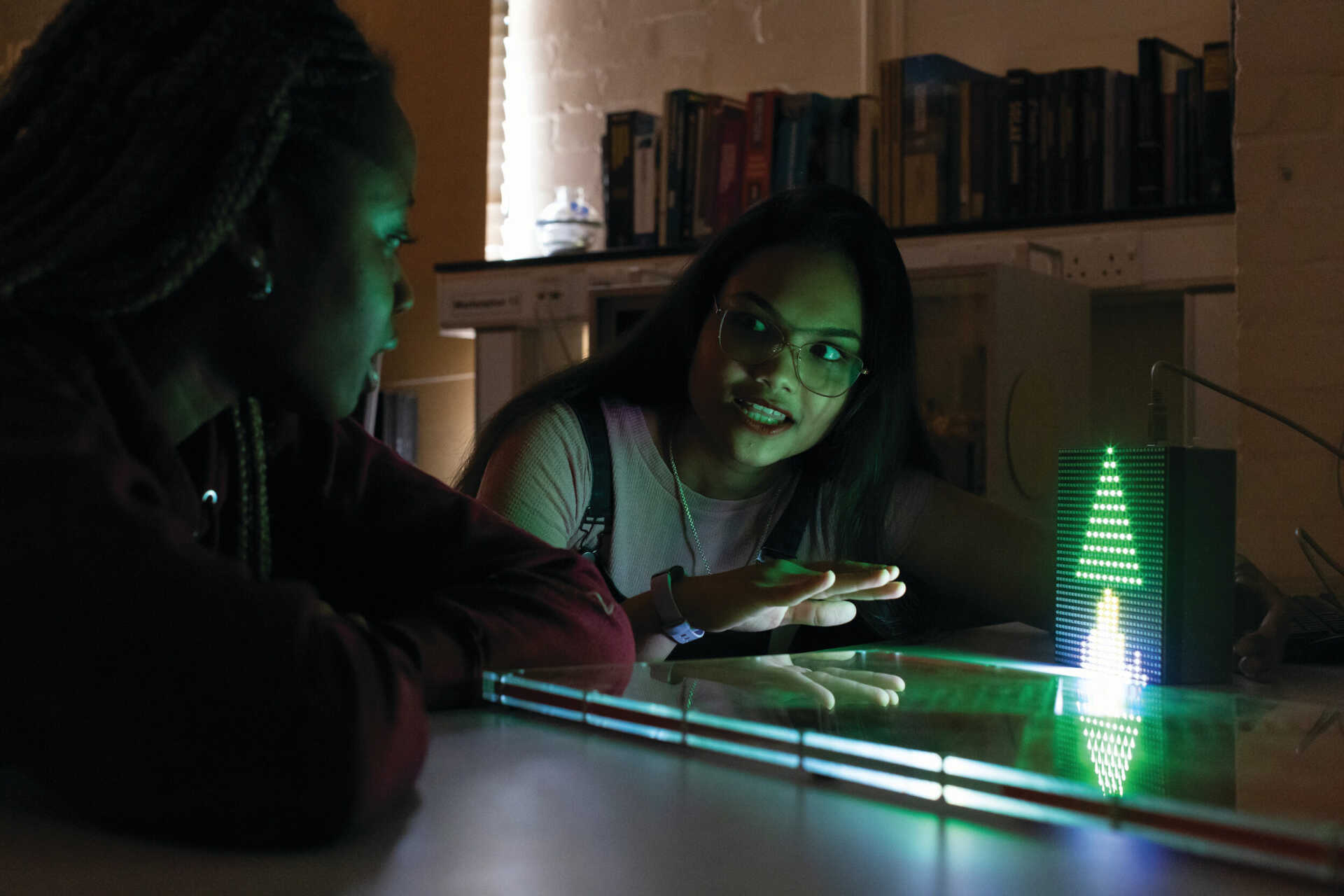
You’ll graduate with an excellent grounding in scientific knowledge and extensive laboratory experience, as well as a toolbox of transferable skills highly sought after by employers. These include excellent communication and problem-solving skills; analytical thinking; effective time management; and the ability to work independently or as part of a team. Our graduates have gone on to work for employers such as:
Read some of their stories and find out about the range of support and extra opportunities available to further your career potential.
Kent was the only university to offer a course directly in line with what I am passionate about.
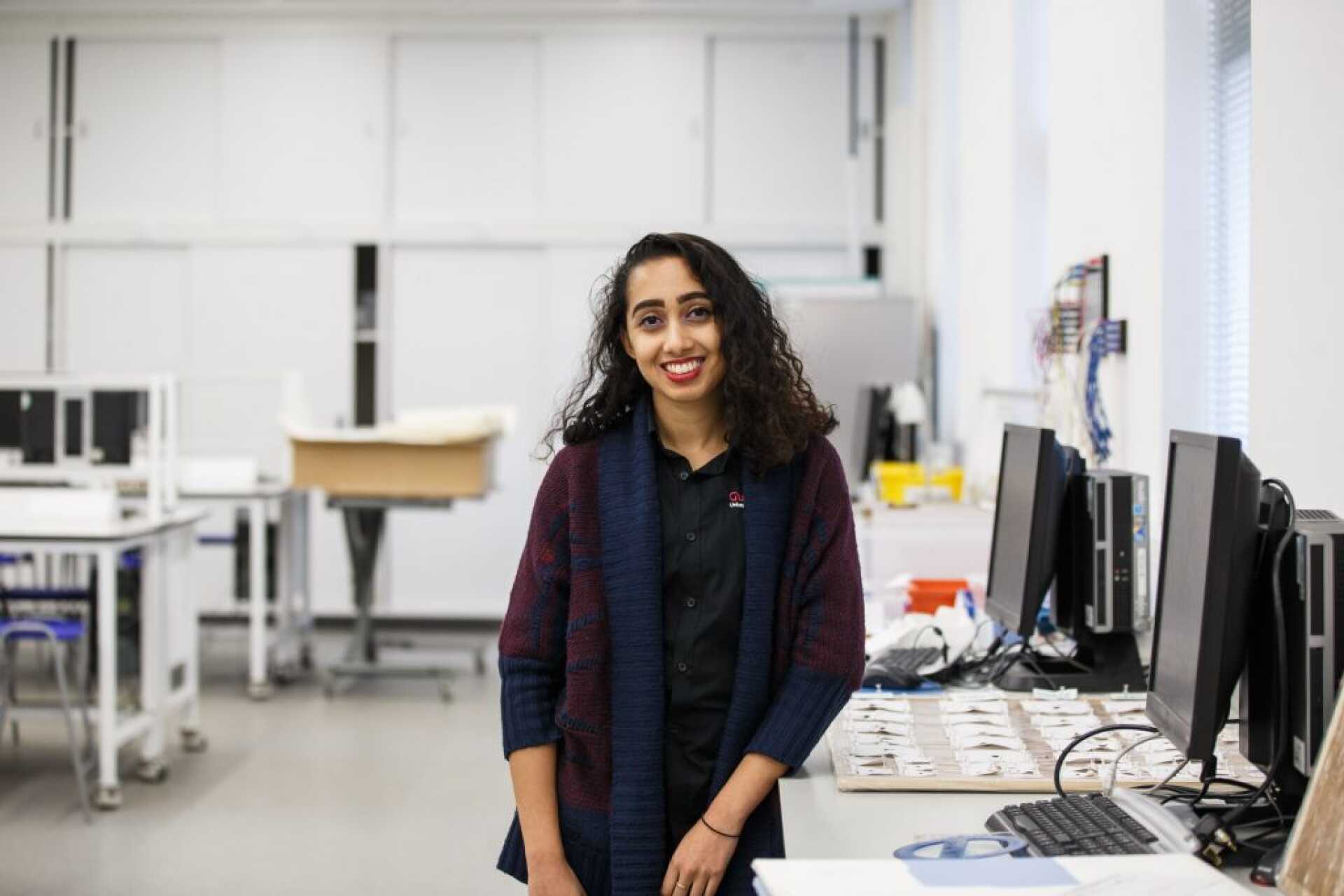
The 2023/24 annual tuition fees for this course are:
For details of when and how to pay fees and charges, please see our Student Finance Guide.
For students continuing on this programme, fees will increase year on year by no more than RPI + 3% in each academic year of study except where regulated.*
The University will assess your fee status as part of the application process. If you are uncertain about your fee status you may wish to seek advice from UKCISA before applying.
Find out more about accommodation and living costs, plus general additional costs that you may pay when studying at Kent.
Kent offers generous financial support schemes to assist eligible undergraduate students during their studies. See our funding page for more details.
At Kent we recognise, encourage and reward excellence. We have created the Kent Scholarship for Academic Excellence.
The scholarship will be awarded to any applicant who achieves a minimum of A*AA over three A levels, or the equivalent qualifications (including BTEC and IB) as specified on our scholarships pages.

We have a range of subject-specific awards and scholarships for academic, sporting and musical achievement.
Join the student-led Physics Society and Space Soc. They organise talks, practical demonstrations and social events. A great way to meet students across year groups.
We welcome applications from students all around the world with a wide range of international qualifications.

Student life

Kent ranked top 50 in The Complete University Guide 2023 and The Times Good University Guide 2023.
Kent Sport
Kent has risen 11 places in THE’s REF 2021 ranking, confirming us as a leading research university.
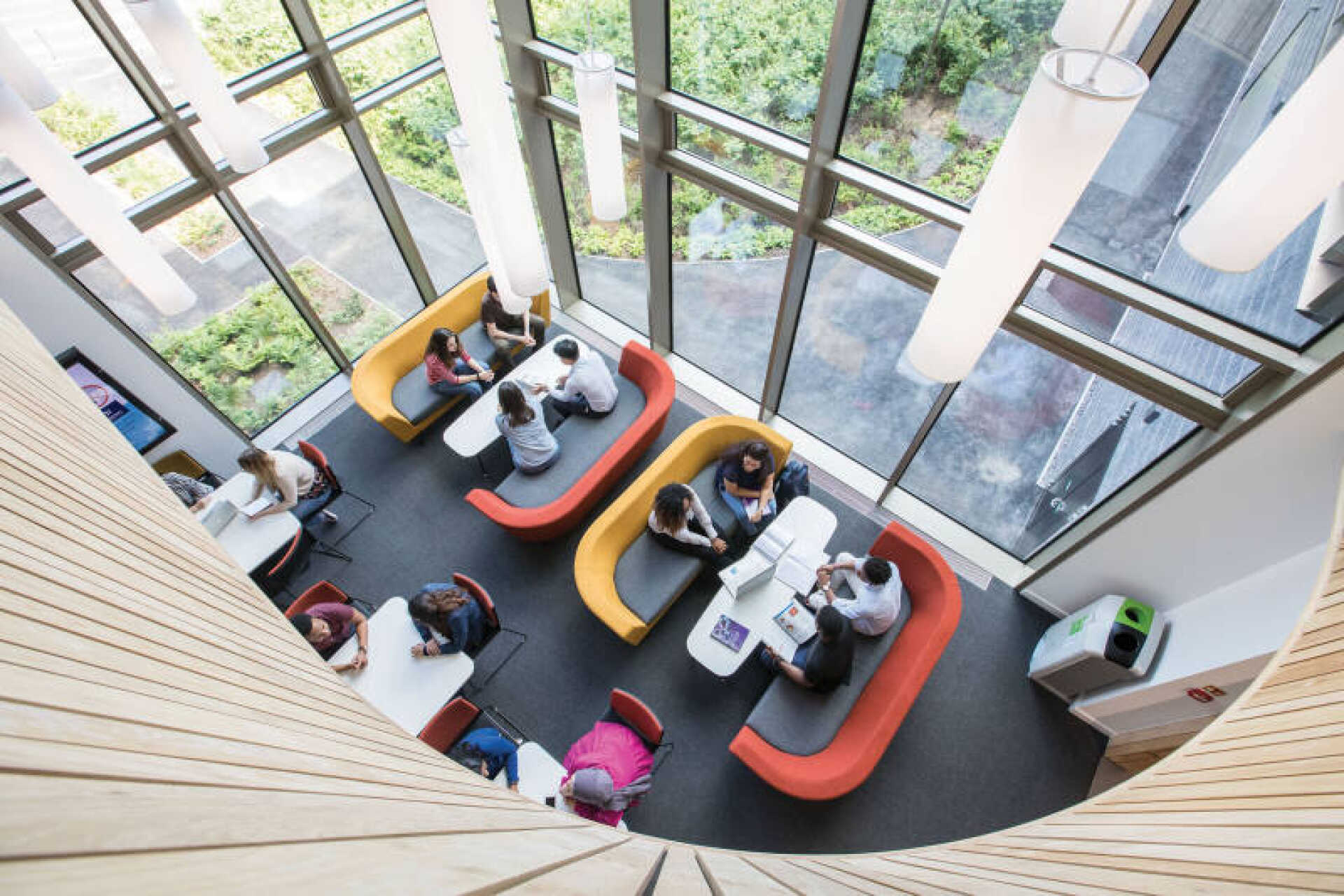
Accommodation